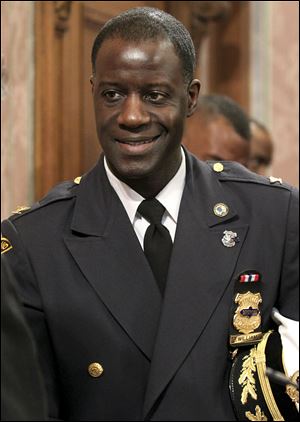
Cleveland releases new rules for police pursuits over a year after deadly chase through city
3/6/2014
The new policy comes more than a year after a chase involving more than 100 officers and 60 squad cars ended with the deaths of two apparently unarmed people. Seen here is Cleveland police chief Calvin Williams.
CLEVELAND — Cleveland’s police department will limit when and how long squad cars can chase suspects in new guidelines released Thursday, more than a year after a chase involving more than 100 officers ended in the deaths of two people.
The revamped policy was in the works before the deadly 23-minute chase that is still being investigated, but what happened that night did influence the new guidelines, said Police Chief Calvin Williams.
One big change is that just two squad cars will be allowed in a chase unless a supervisor authorizes more cars to get involved.
The changes come as the department is still dealing with the fallout from the November 2012 chase that involved five dozen cruisers and wove through residential neighborhoods, onto Interstate 90, and eventually ended with gunfire in East Cleveland. Officers fired 137 shots.
Critics called the shooting a racially motivated execution. Both victims were black, and no weapon was found. The police union defended the officers’ actions and said the driver was trying to ram them.
The police department is now under a wide-ranging federal investigation into the use of force that goes beyond the car chase. A county grand jury is also investigating the 13 officers who fired shots during the November 2012 chase.
The police chief said the new policy makes it clear who is in charge when there is a chase. Officers will still be able to pursue someone suspected of a violent felony or drunk driving, Williams said.
Police union leader Jeff Follmer told WKYC-TV the new 16-page policy puts more pressure on officers and their supervisors.
“It’s 16 pages, where we don’t have but 16 seconds to make a decision out there, and that’s the reality of police work,” he said.
Police don’t know why the driver in the November 2012 chase, Timothy Russell, refused to stop. Russell, 43, had a criminal record including convictions for receiving stolen property and robbery. His passenger, Malissa Williams, 30, had convictions for drug-related charges and attempted abduction.
Russell was shot 23 times and Williams was shot 24 times.
An investigation by the Ohio attorney general blamed police leadership and communications failures in the chase.
The estates of Russell and Williams sued the city, the mayor and police. The lawsuit, which is still ongoing, asked the court to order the city to make changes in police policies to prevent similar incidents.